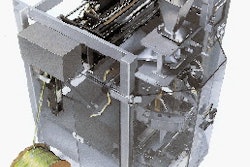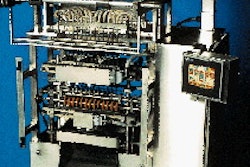
The session, "Training your trainers to train," was chaired by Glen Long, vice president of BWI Packaging Technologies (Davenport, IA), who serves as chairman of the PMMI Training Committee. Panelists included Kenneth W. Crompton, P.E., director of engineering for the snacks and beverages unit of Hunt-Wesson, Inc., Fullerton, CA; Wade A. Latz, Hershey Foods' manager of packaging systems engineering in Hershey, PA; and Larry Posluszny, manager of engineering and maintenance training at the Anheuser-Busch University, St. Louis.
All three panelists urged the machinery builders to provide professional trainers, not just technical service people, when they conduct training for end-users. "Our customers have called us on this," Long emphasized to the audience of machinery makers. "They've told us what we're offering is not sufficient. You can't really blame them when a trainer begins a session by saying: 'I'm not sure if the information in the text is correct. I just got the books this morning before class.' That's a powerful example of what some of our trainers are saying out in the field."
Long then paraphrased short descriptions of what the three packaging panelists say they
seek in training:
* Training documentation is as important as machine design capability;
* If a company buys a quality piece of equipment, it should expect a quality training
program to support it; and
* The best packaging equipment makers deliver systems, not machines. Systems include machines and people working together.
Long called these descriptions "evidence that our customers see us providing a service, not just manufacturing or designing. They see us supplying solutions to the problems they face, and they want that relationship."
Improving skills at A-B
"Our goal is to create a dynamic learning environment for our employees so they have the skills to help them in their jobs," A-B's Posluszny began. The brewery trainer then referred to an article from a PMMI newsletter that discussed the base reading levels of employees.
In the article, machinery manufacturers discuss the need for writing manuals at the eighth- and ninth-grade education levels. "We offer a voluntary skills improvement program to help our employees improve their reading, math and writing skills to the levels necessary for understanding the manuals that are provided to them. Achieving a level of mastery in these skills is an important goal at A-B."
Posluszny went on to describe the establishment, January 1, of Anheuser-Busch University, and the Production and Engineering College that he represents. That group was responsible for over 600ꯠ hours of training in '97, he says, with about 30% of that training performed by Anheuser-Busch's vendors or Original Equipment Manufacturers.
"The only way we can be successful with vendor training is to communicate our expectations to our suppliers," he emphasized. "We have begun to specify our expectations on our bid packages. And we come to meetings like this to help our vendors understand our expectations, and to help you to meet them."
Preparing A-B's employees
While the principal objective was to establish a well-trained workforce, A-B's second objective was more proactive: It wants suppliers to leave behind a training program that the breweries can use in the future. "We need to protect our assets," Posluszny said, "and our assets are the people at the plants. We need to prepare them in the best possible ways."
A-B's requirements include four areas: program content, training materials, instructional tools and qualified instructors. In terms of content, Posluszny explained that one of the expectations is that training not only addresses the skills needed to do the job, but also the knowledge level. Thus, training needs to answer questions such as "How and why do we do things?" The workers, he said, need to understand the ramifications of good and bad decisions, and if a poor choice is made, how it can be fixed.
The company also wants to understand what prerequisites are needed before a worker attends a training session. "Unless we prepare our people properly before a vendor's trainer shows up, we don't stand a chance of really teaching them what they need to know," the speaker noted. A-B also would like training manuals to be specific to A-B plants, and the brewer can supply formats and guidelines that are similar to those recommended by PMMI.
In terms of instructional aids, Posluszny said that A-B wants tools that will permit instructors to teach a consistent, repeatable message day-in and day-out. Often over a period of time, he says, A-B will use different instructors for the same training, and the instructional tools will help ensure consistent results.
Certifying trainers
"We can put all the time, resources and money into materials, but on the day the instructor shows up, if he or she is not qualified and certified, we have lost valuable time and opportunity," A-B's Posluszny stressed.
This loss isn't caused by a lack of technical knowledge. "What's more important is that trainers have the abilities to present and communicate their knowledge, so our employees will gain the information and skills they need," he added. That's why A-B has developed an OEM training certification program that includes reviews and approvals of vendor training materials, training of vendor instructors and course evaluation. This free three-day program is designed for A-B's suppliers.
For vendor instructors, the program teaches presentation skills and on-the-job training. "We think one of the most important pieces to this whole program is the valuable feedback we receive from supplier instructors about our expectations and our training course," Posluszny says. "Often what we learn from our vendors helps all of us do a better job."
Training can drive purchasing
Hershey's Wade Latz was emphatic about the importance of strong training to repeat equipment purchasing. At the food company's 22 North American plants, Hershey spent over $20 million on packaging equipment alone last year. Company headquarters does not dictate which equipment is to be purchased. "Nor do we have corporate-wide standards for major packaging equipment that's based on preferred suppliers," stated Latz.
"How much our people know-and how they feel about a vendor's equipment-will determine what we buy," he told the PMMI audience. "The picture in our workers' minds of your company is formed by their feelings about the equipment gained from experience. More importantly, it's a reflection of the skills, demeanor, attitude, confidence and educational proficiency of the trainers from your companies," he told the equipment makers.
Latz didn't pull any punches as he described the results often obtained when service technicians or engineers perform training as a secondary responsibility. "This usually produces marginal results, and sometimes makes things worse, due to poor preparation, inexperience, or, in general, bad chemistry. Meaningful training programs with dedicated trainers are rare among packaging machinery suppliers.
"Professional, well-thought-out educational programs, coupled with good educators, will result in customers who understand, are confident with or are excited about your equipment, your company and your people," Latz said. "Good business will follow."
Crompton heartily agrees
Not so long ago, Hunt-Wesson's Ken Crompton recalls this answer when suppliers were asked for training: "Send Joe for an extra day." Today, Hunt's costs for packaging production lines have gone up tremendously, "and I think it's because of all the wealth we've generated out there in this room," he chided the PMMI members.
"Seriously, we don't put a line in today with less than $3 million just for the hardware. When you add in the buildings and facilities that support that line, you get into tremendous investmentso/ooWhat is typical today, is that the equipment selection is really based on your training and documentation capabilities," he told the equipment makers.
In 1998, this is one of eight to 10 criteria that Hunt's equipment selection teams use. "Training and documentation wasn't on that list five or ten years ago. But it is now," Crompton states. He also explained that his company now insists on having its operations and maintenance people at machinery factories during construction and of the equipment.
"This way, we involve our operators and maintenance people, and we feel the best time to learn is in a supplier's plant. Some equipment builders don't like this, but be prepared. It's only going to increase."
Crompton echoed Posluszny's request that training be customized. "Canned training programs must be adapted to the capabilities of our people. We know what those capabilities are and we'll help vendors adapt their programs."
Committing to training
Classroom training is a relatively new concept, Crompton says, and he sees it as an indicator of the thoroughness of the training system. Post start-up training courses have been set up with some vendors, he points out, "and they do refresher visits for up to one or two years after equipment installation."
However, among packaging equipment suppliers, he claims some are committed to training and others don't want to be involved in it. And this is not dependent on the size of the company. "We see it in both large and small companies."
The biggest obstacle he sees is that many suppliers have no personnel dedicated to training. This, he says, is a critical factor in its evaluation of a company as a vendor. "If I could leave here having firmly implanted in your minds the importance of having dedicated trainers," he stressed, "I'd consider this meeting a real success."
Crompton then ticked off a short checklist of shortcomings Hunt-Wesson frequently experiences with packaging suppliers:
* Often little thought is given to safety training to reduce a manufacturer's liability and the liability of the equipment maker;
* No provisions for training follow-ups, such as inspection monitoring and feedback of our operators and maintenance crew;
* In terms of documentation, the lack of "as-built" drawings or complete parts lists;
* Poor recordkeeping related to parts information or drawings; and
* No standards for documentation of control logic.
Crompton punctuated each of these points with anecdotes. And he also admitted that his company was not without its faults. "We have not yet completed an outline of training system elements required when you supply equipment to us. We are developing it-pieces of it are finished-but it's not totally complete."
Crompton concluded by saying the company plans to withhold final payments for projects until the documentation and training is completed to satisfaction. "This is really the only 'stick' we have to get what we need. We have not done this in the past. But in the future we will."
In a question period following the presentations, the panelists were asked if they could measure the benefits of training. All said yes, and A-B's Posluszny explained how his company documents it. "The start-up curve is always calculated and published as part of the project submittal and request for funding. Our operating budget plan is actually based on that start-up curve.
"Within the last five years, with our renewed focus on establishing our own training systems and adapting those from suppliers, we've seen pretty significant progress made in taking a steeper start-up curve. And believe me," he says, "that's a lot of dollars to us."
Crompton seconded this, saying that Hunt-Wesson reports quicker turn-overs of equipment and lines from suppliers to in-house operators and maintenance people. "There are too many variables to link downtime, but we're shooting for quicker transitions of projects between vendors and our people."






















